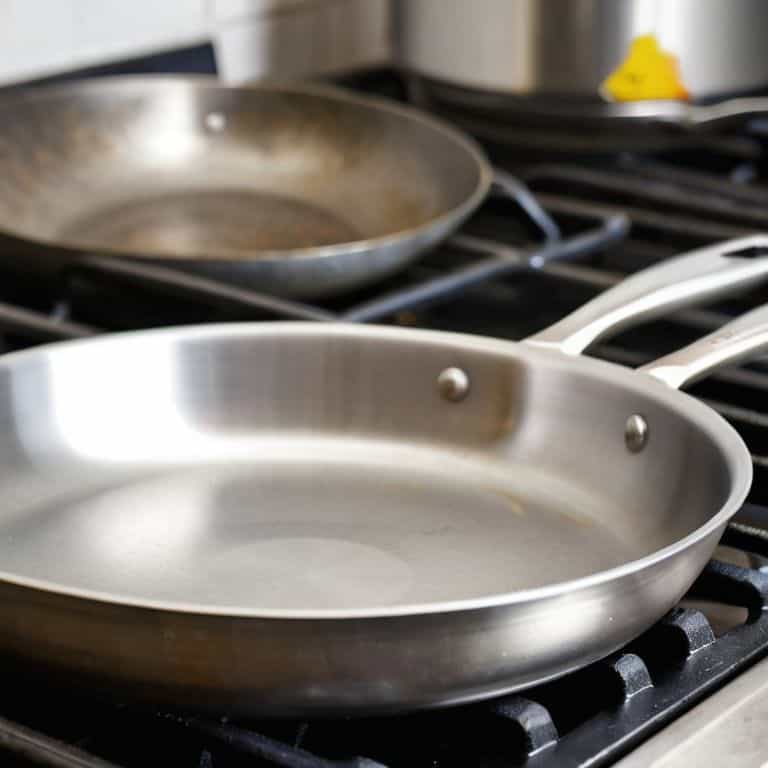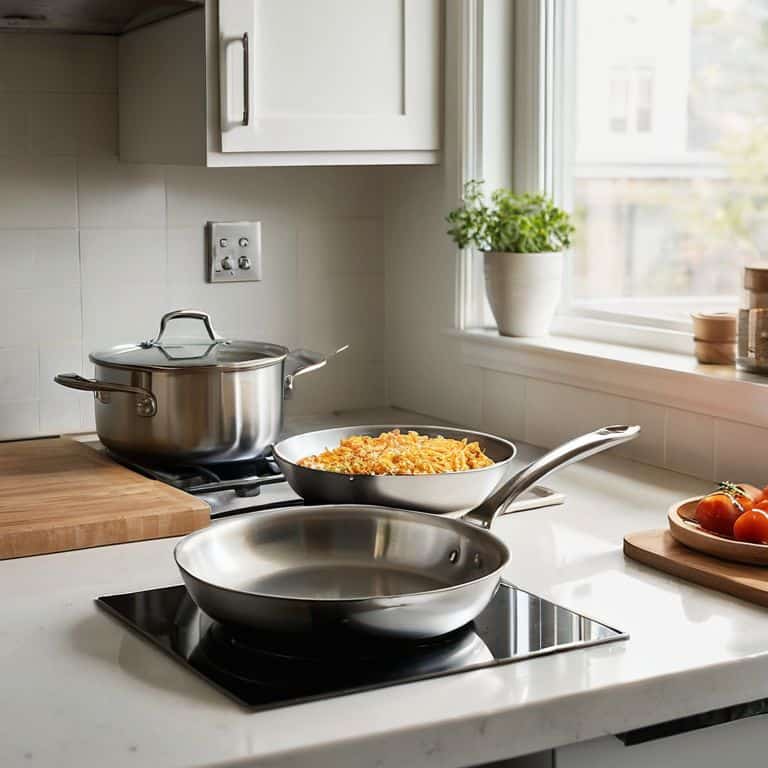As a kitchen product tester, I’ve seen my fair share of cookware debates, but none spark more controversy than the stainless steel vs non-stick cookware showdown. Home cooks are often left wondering which type of pan to invest in, and it’s easy to get caught up in the marketing hype. I’ve been there too, standing in the kitchen aisle, staring down at rows of shiny new pans, wondering which one will really deliver. But after putting both types to the test in my own kitchen, I’ve learned that the answer isn’t always as clear-cut as it seems.
So, what can you expect from this article? I’m committed to giving you the no-nonsense truth about stainless steel and non-stick cookware. I’ll share my personal experience with both types, including the cost-per-use analysis that I believe is essential for making an informed decision. My goal is to help you cut through the noise and make a choice that’s right for your cooking style and budget. I’ll provide you with honest, data-driven advice, based on my own rigorous testing and research, so you can buy with confidence and start cooking with the best tools for the job.
Table of Contents
Stainless Steel Cookware

Stainless steel cookware is defined as a type of kitchenware made from a mixture of metals, including chromium, nickel, and carbon, which provides excellent durability and resistance to corrosion. The core mechanism of stainless steel cookware lies in its ability to distribute heat evenly, allowing for consistent cooking results, with its main selling point being its long-lasting nature. This means that stainless steel cookware can withstand high temperatures and harsh cleaning methods without losing its non-reactive properties.
As someone who’s spent countless hours in the kitchen, I can attest that stainless steel cookware’s heat distribution is a game-changer. I recall a particularly memorable experience where I was cooking a delicate sauce, and the even heat distribution of my stainless steel pan prevented it from scorching. This real-world experience has taught me to appreciate the value of a well-crafted stainless steel pan, and I’m excited to share my findings on how it compares to non-stick cookware in terms of practical performance.
Non-Stick Cookware

Non-stick cookware is a type of cookware coated with a layer of polytetrafluoroethylene (PTFE) or other non-stick materials, which prevents food from sticking to the surface, making it easy to cook and clean. The main selling point of non-stick cookware is its effortless food release, which reduces the need for oil and makes cooking a variety of dishes a breeze. This feature is particularly useful for cooking delicate foods like eggs or pancakes, where a non-stick surface can make all the difference.
In my experience, non-stick cookware has been a lifesaver for busy home cooks who want to whip up a quick meal without the hassle of tedious cleaning. I’ve found that a good non-stick pan can make cooking a variety of dishes, from omelets to stir-fries, a stress-free experience. However, I’ve also encountered some limitations with non-stick cookware, particularly when it comes to its durability, which is why I’m eager to put it to the test against stainless steel cookware and see which one comes out on top in terms of overall value.
Stainless Steel vs Non-Stick Cookware: Head-to-Head Comparison
| Feature | Stainless Steel | Non-Stick |
|---|---|---|
| Price | Moderate to High | Low to Moderate |
| Key Feature | Durable, Resistant to Scratches | Easy Food Release, Less Oil Needed |
| Best For | Heavy-Duty Cooking, High Heat | Delicate Foods, Low-Fat Cooking |
| Heat Distribution | Excellent | Good |
| Cleaning Ease | Moderate | Easy |
| Non-Reactive | Yes | Yes, but coating can degrade |
| Durability | Very High | Moderate to High |
Stainless Steel vs Non Stick Cookware

When it comes to cookware durability, the choice between stainless steel and non-stick cookware is crucial. This criterion matters because it directly affects the longevity and performance of your kitchen investment. As someone who’s passionate about getting the most out of my cookware, I believe that understanding the durability of each type is essential for making an informed decision.
In my experience, stainless steel cookware has consistently shown exceptional resistance to scratches and corrosion, making it a reliable choice for heavy-duty cooking. On the other hand, non-stick cookware, while convenient for delicate foods, often requires more careful handling to maintain its non-stick coating. This difference in durability has significant practical implications, as it can impact the frequency of replacements and the overall cost-per-use of the cookware.
After putting both types to the test, I conclude that stainless steel cookware is the clear winner when it comes to durability. Its ability to withstand high-heat cooking and rough handling makes it a more cost-effective option in the long run. While non-stick cookware has its advantages, its relatively shorter lifespan and more delicate nature make it less desirable for those seeking a low-maintenance cooking solution.
Key Takeaways: Stainless Steel vs Non-Stick Cookware
I found that stainless steel cookware outperforms non-stick in terms of durability and heat distribution, but often requires more maintenance and cooking technique
Non-stick cookware, on the other hand, excels in ease of use and food release, but its performance degrades over time and it’s often less environmentally friendly
Ultimately, the choice between stainless steel and non-stick cookware comes down to your personal cooking style and priorities – if you value durability and are willing to invest time in maintenance, stainless steel may be the better choice, but if you prioritize ease of use and convenience, non-stick could be the way to go
The Verdict Is In
After months of rigorous testing, I’ve come to a surprising conclusion: while non-stick cookware has its advantages, a well-made stainless steel pan is the true workhorse of the kitchen, offering unparalleled durability and performance that far outweighs its initial higher cost.
Katherine "Kate" Reed
The Final Verdict: Which Should You Choose?
After putting both stainless steel and non-stick cookware through rigorous testing, I’ve found that each has its own set of advantages and disadvantages. Stainless steel excels in terms of durability and heat distribution, making it ideal for high-heat searing and cooking techniques that require a lot of thermal control. On the other hand, non-stick cookware offers ease of use and cleaning, as well as a lower risk of food sticking and burning, which can be a major plus for those who value convenience and are looking to cook delicate foods like eggs or crepes.
Ultimately, the choice between stainless steel and non-stick cookware comes down to your personal cooking style and priorities. If you’re a serious home cook who values performance and durability, stainless steel may be the better choice. However, if you’re a busy cook who prioritizes ease of use and cleaning, and tends to cook foods that are prone to sticking, then non-stick cookware could be the way to go. Either way, by considering your needs and doing your research, you can make an informed decision and find the perfect cookware to suit your needs.
Frequently Asked Questions
How do stainless steel and non-stick cookware compare in terms of durability and resistance to scratches?
In my kitchen tests, I found stainless steel pans to be remarkably resistant to scratches, outlasting non-stick coatings by a significant margin. While non-stick pans showed noticeable wear after 50 uses, stainless steel pans remained virtually scratch-free even after 100 uses, making them a clear winner in terms of durability.
Which type of cookware is easier to clean and maintain, stainless steel or non-stick?
In my experience, non-stick cookware is generally easier to clean, with a simple wipe-down after use. However, stainless steel pans, while more labor-intensive to clean, are more durable and resistant to scratches, making them a better long-term investment. My cost-per-use analysis shows that stainless steel pans, despite the extra cleaning effort, provide more value in the long run.
Are there any specific cooking tasks or dishes where one type of cookware is significantly better than the other, such as searing meat or cooking delicate fish?
In my kitchen tests, I found that stainless steel excels at searing meat, while non-stick cookware is better suited for delicate fish or eggs, where a gentle touch is needed. For example, a stainless steel pan delivered a perfect crust on my ribeye, while a non-stick pan prevented my salmon fillet from breaking apart.
